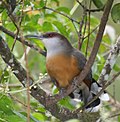Description and ecology
These birds are of variable size with slender bodies, long tails and strong legs. Many have black and white undertail patterns. They occur in a variety of forests, woodlands or mangroves.
Coccyzus cuckoos, unlike many Old World species, build their own nests in trees and lay two or more eggs. Yellow-billed and black-billed cuckoos occasionally lay eggs in the nests of other birds, but are not obligate brood parasites like the common cuckoo of Eurasia.
Northern species such as yellow-billed and black-billed cuckoos are strong migrants, wintering in Central or South America, and occasionally wander to western Europe as rare vagrants, but the tropical Coccyzus cuckoos are mainly sedentary.
These are vocal species when breeding, with persistent and loud calls. They feed on large insects such as cicadas, wasps and caterpillars (including those with stinging hairs or spines which are distasteful to many birds). Lizard cuckoos are large and powerful species, and mainly take vertebrate prey, especially, as the name implies, lizards.
This page is based on this
Wikipedia article Text is available under the
CC BY-SA 4.0 license; additional terms may apply.
Images, videos and audio are available under their respective licenses.













